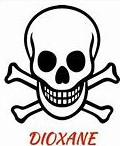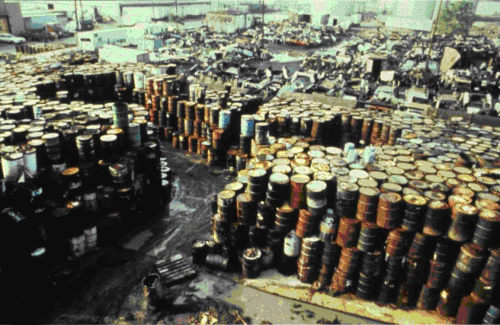Residential Water Treatment for 1,4-Dioxane
by Gene Franks

According to the Environmental Working Group, water supplies for more than 7 million Americans in 27 states are contaminated with an industrial chemical at levels higher than what is generally considered safe. The chemical, known as 1,4-dioxane (often called simply dioxane), is especially troubling in certain areas of high concentration, most notably Long Island, NY, the Cape Fear River area of North Carolina, and Los Angeles county in California.
Although the EPA has set no formal standard for 1,4-dioxane (and don’t expect it soon), the current safe limit being used by most agencies is 0.35 ppb. That’s the level expected to cause no more than one case of cancer for every million people who drink the water daily for a lifetime. Contaminant levels much higher are being found in the areas mentioned and in other parts of the country. The EPA has classified 1,4-dioxane as “likely to be carcinogenic to humans.” Dioxane is also listed in California’s official registry of chemicals known to cause cancer.
Dioxane is a man-made chemical mainly used (90%) as a stabilizer for another man-made water contaminant, the solvent TCE. The main source of 1,4-dioxane in drinking water is from leaking underground storage tanks at hazardous waste sites and from discharges from manufacturing plants. Other significant sources of exposure to the chemical include personal care products like shampoos, deodorants and lotions as well as laundry products and household cleaning products. 1,4-dioxane is in these products not as an intended ingredient but as a contaminant from the manufacturing process.
As with many contaminants, most of the research done on 1,4-dioxane treatment is focused on large applications like wastewater treatment plants and municipal water suppliers. Often, methods that prove effective for large operations are impossible to apply to residential treatment. In the case of dioxane, advanced oxidation processes involving hydrogen peroxide with ultraviolet (UV) light or ozone and anion exchange with specialty resins are used with some success to treat 1,4-dioxane. These large-scale methods are not practical for residential users.
Information about 1,4-dioxane as a residential contaminant and how to treat it is scarce and inconsistent. For residential treatment the old standby products carbon filtration and reverse osmosis seem to be the best things available, although very little actual testing seems to have been done to establish their effectiveness.
One North Carolina State University researcher says, “Most in-home water filters, including activated carbon filters, don’t remove 1,4-dioxane effectively. Reverse osmosis filters are better, removing a significant portion of the chemical from tap water, but still fall short.” Not exactly helpful if you’re designing a home treatment strategy, but typical of the information available. One leading internet vendor recommends whole house reverse osmosis at $10,000. Between the lines reading of the not-very-helpful advice on residential treatment indicates that filter carbon works, but not as well as one would hope, that it works best if there is long contact time (large filters and reduced flow rates), and that nutshell carbon seems to work better than coal-based. As for reverse osmosis, everyone agrees that it is effective but no one has established any hard information about rejection percentages.
To plan residential treatment for any contaminant, one needs to consider first how the contaminant is taken in by humans. In this area, too, there is a disturbing lack of information and a lot of contradictory information about dioxane. Water contaminants can be ingested by drinking contaminated water, or breathed in as a vapor or taken in through the skin. Showering is a common hazard since the contaminant can be taken in through the skin or breathed in if it vaporizes. Arsenic, to illustrate, does not evaporate into the air and is not easily absorbed through the skin, so there is little need for “whole house” treatment. Chlorine, conversely, vaporizes easily in the shower and also penetrates the skin, so whole house chlorine treatment is important.
Information about dermal and inhalation exposure to dioxane varies so much that it is essentially useless. The consensus is that it evaporates so quickly that dermal uptake is minimal; but this, of course, makes it more likely that it is breathed in during showering. To complicate the issue, because so many bath products are possible sources of the chemical, it is hard to know how much exposure is avoided by treating the water itself. It certainly makes no sense to install an elaborate and expensive system to remove 1, 4-dioxane from the water you shower with and then use a shampoo that contains the contaminant.
Treatment
Our recommendation for residential 1,4-dioxane protection is the same as for contaminants like fluoride, arsenic, and chromium. Install a high quality reverse osmosis unit that has at least two carbon stages for drinking water. An undersink RO unit should be a standard feature in all homes. For the whole house, carbon filtration, either as carbon block cartridge filters or a tank-style backwashing filter, provides broad protection against most contaminants and should reduce exposure to dioxane. We do not believe that installation of over-sized carbon tanks just to treat dioxane is advisable.

Leaking underground storage tanks at hazardous waste sites and discharges from manufacturing plants are important sources of 1,4-dioxane water contamination. Other significant sources of exposure to the chemical include personal care products like shampoos, deodorants and lotions as well as laundry products and household cleaning products.






